
A wreath is first and foremost an expression of unity. No matter the materials used or style, every wreath begins as a circle. A circle is a complete, continuous, and visually satisfying form. That decorated shape displayed at the holidays expresses the sentiments of the season, as well as a point of view about beauty. This simple grapevine wreath adorned with a few dried bits from the garden and a wired paper bow says hello and welcome.
The history of wreath making is long, dating back centuries. Holiday wreaths traditionally begin with a circle of evergreens. The evergreens last a long time, despite being cut. There is a strong element of hope associated with evergreen wreaths-that despite the quiet winter season, the natural world is still very much alive, and will persist through the winter.
All of the evergreen wreaths at the shop are locally made to a certain size and heft that will keep its shape, no matter how much I may add to it. The handmade part of them is obvious-they are not perfectly round, and they have a lively textured surface.
I like a basic mix of different types of fir. Douglas, concolor, silver, noble and frazier fir stay fresh looking a long time. Adding bits of other greens, such as boxwood, incense cedar, berried juniper and the like makes each wreath different-more personal.
Decorating a wreath spices up the evergreen stew. Natural materials-cones, mosses, dried berries, magnolia leaves, twigs, and eucalpytus provide color and texture of a different sort. Arranging all of the materials-a satisfying and contemplative exercise in composition.
I probably make upwards of 50 wreaths a year-how I enjoy this. Each client has a singular idea about what they like in terms of color, materials and style. Some are quite formal-others more low key.
The mechanics of fastening has everything to do with the weight of the material and size of the material you are trying to attach. Wire can be wrapped around the base of a pine cone, and poked through to the back of the wreath. Anything that gets wired to the steel base of the wreath will stay put, no matter how blustery the weather. I buy rolls of paddle wire. The 22 gauge green wire is a continuous length wound round a paddle shaped spool. I always have the perfect length of wire available.
Florist’s wire comes in different lengths and weights. The advantage of this wire-it is straight. A straight wire can be easier to poke through the evergreens. Smaller materials like twig bunches can be easily fastened with a single piece of wire.

Some wreath materials are available already attached to heavy wire stems. They can be wedged in between the evergreen branches. More often than not, I take the picks apart. Many are just too large, or too long for the spot where I need them. The acorn branches in the wreath pictured above came from a single pick.
A jute bow is easy to attach with a zip tie that goes through the center knot, and around a stout branch. Really heavy materials, such as faux fruit or ornaments like the bead ball pictured above need a fastening device that is both strong and rigid. Floral picks, or skewers come in various lengths, and can handle the heaviest ornament with ease. Faux fruit is really tough skinned. I pierce the surface with a steel awl, butter the pick with hot melt glue, and insert the pick. The wood pick can them be wired to the steel wreath frame.
The hot melt glue gun is an indispensable, albeit dangerous tool. Hot melt glue will stick to your skin just like anything else it touches. My downfall almost always involves gluer dripping from the back of a piece of moss. If you are using a glue gun more than 1 step from a sink, keep a bowl or glass of water handy, so you can put out the fire fast. Gluing the sticks in the wreath above-not so dangerous. The glue is at the other end. This gluing project just took lots of time. A wreath like this can last many years-and can be repaired if need be.
I don’t really have a favorite wreath. The favorite part is in the making, not in the end result. Having some time, and a good sized space to make a mess is a big help. Wreath making-a primitive form of cutting and pasting. Much more ends up on the floor or table, than on the wreath.
Hand made holiday decorations have a very special feeling about them.
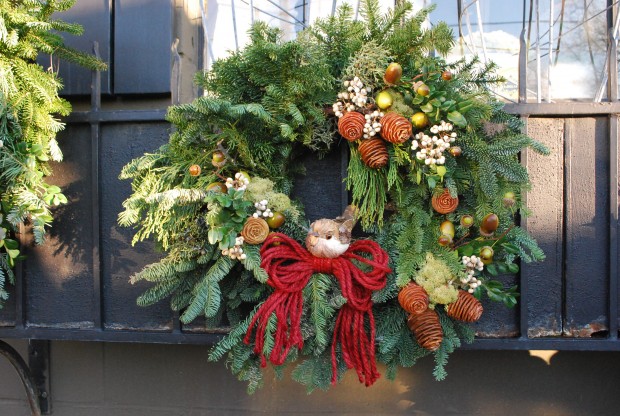
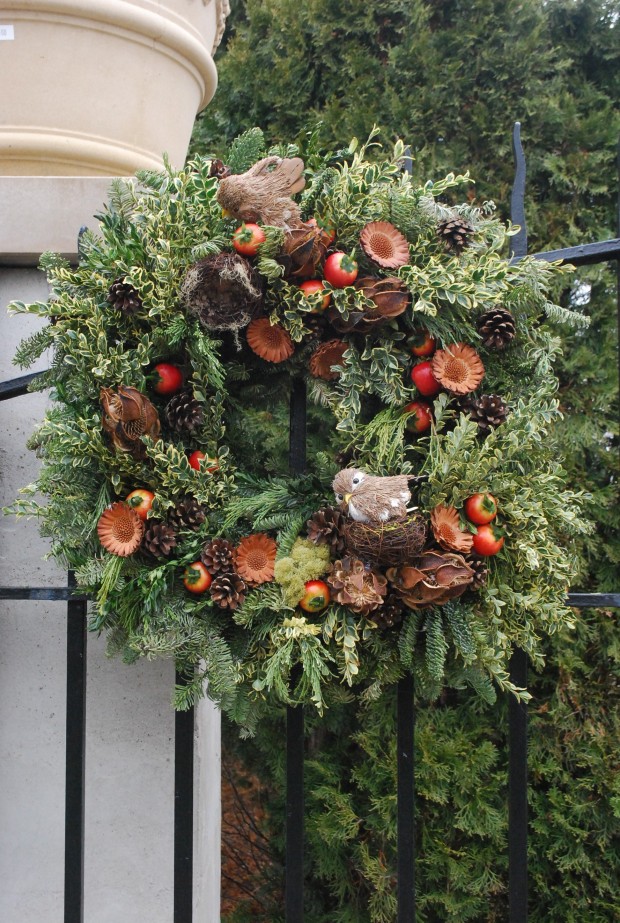


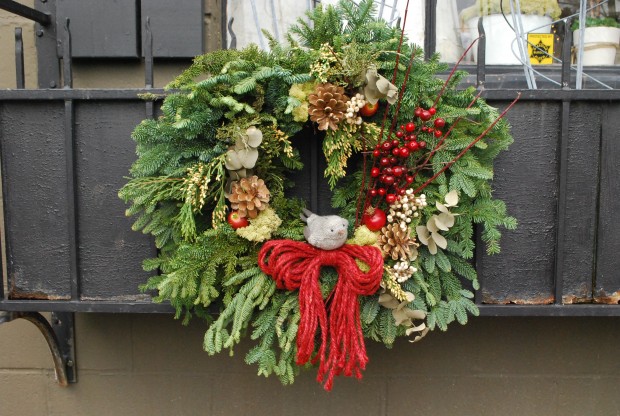
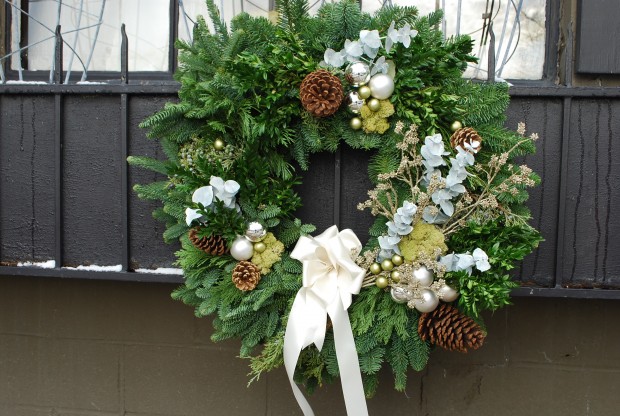
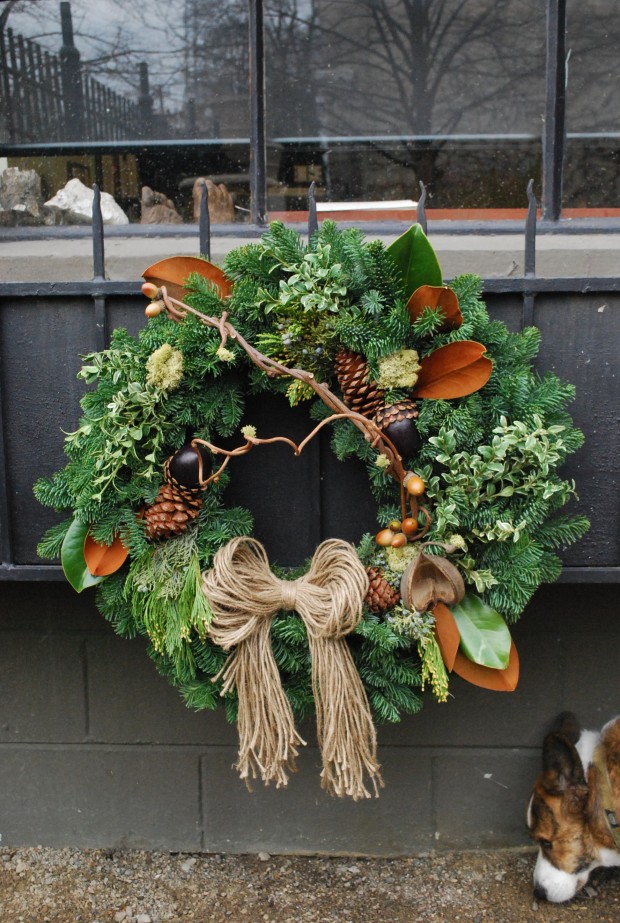

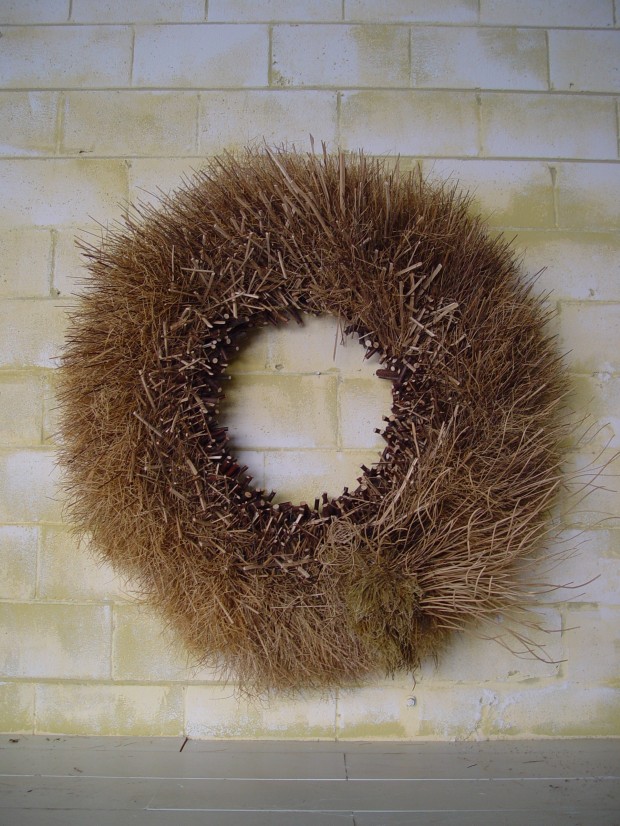
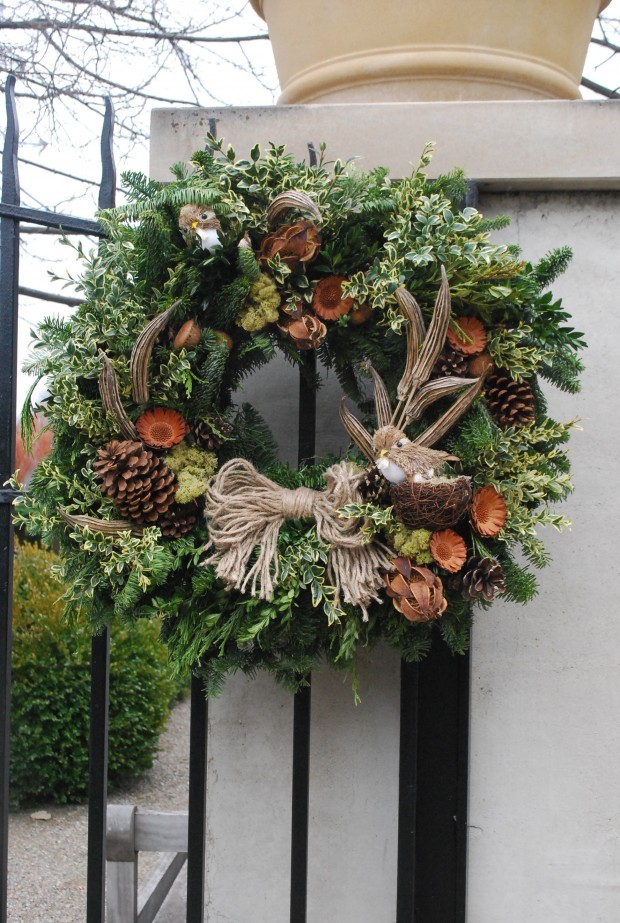


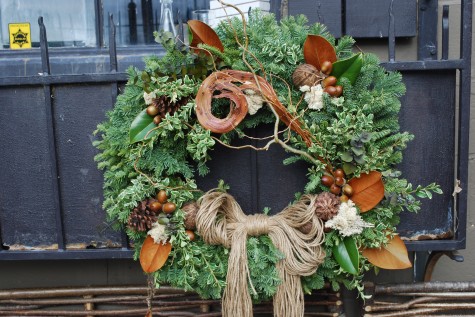

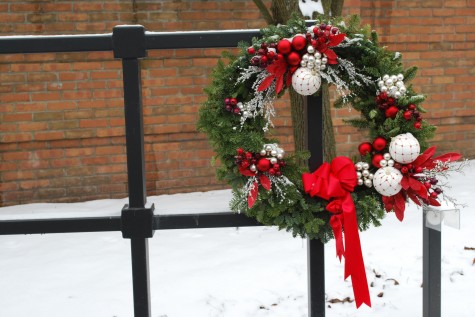
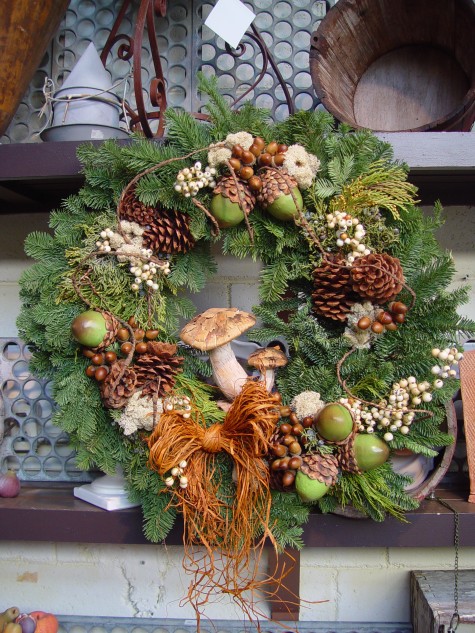

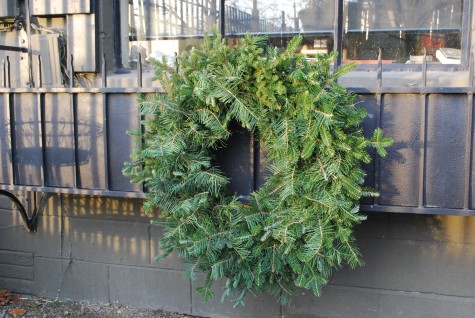

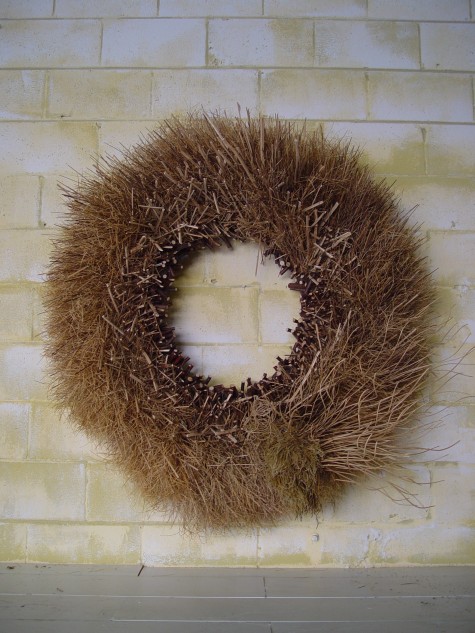

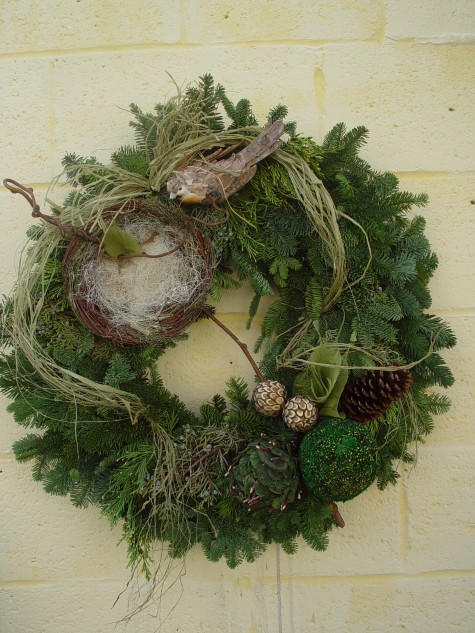
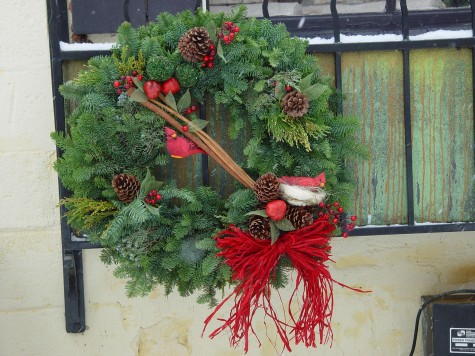 The grocery store is a great source for natural materials; you can find cinnamon sticks this time of year in the spice department. Nuts and dried fruits, sprigs of fresh rosemary-all these things look great. Artichokes and pomogranites are easy to wire and attach fresh, and dry just fine. I avoid piercing any fresh material if I can; there is no need to invite rot. Forest floor litter can be a good source of materials as well-bracket fungus, cones, moss bits and twigs-all these things endow a wreath with a garden feeling.
The grocery store is a great source for natural materials; you can find cinnamon sticks this time of year in the spice department. Nuts and dried fruits, sprigs of fresh rosemary-all these things look great. Artichokes and pomogranites are easy to wire and attach fresh, and dry just fine. I avoid piercing any fresh material if I can; there is no need to invite rot. Forest floor litter can be a good source of materials as well-bracket fungus, cones, moss bits and twigs-all these things endow a wreath with a garden feeling.  Some faux material is too awkward to wire. In the case of this nest, and the bark birds, I pierce the back of the object, and glue in a florist’s skewer; kitchen skewers would work just as well. Transparent materials, such as these skeletal leaves, gain visual weight when used in numbers. I can wedge the skewer into the woody branches of the evergreens. I try not to push the skewer in too far; avoid making your birds look pasted on the greens. Transparent materials, such as these skeletel leaves, gain visual weight when used in numbers; these are wired and glued on a short skewer. Loose and airy looks good.
Some faux material is too awkward to wire. In the case of this nest, and the bark birds, I pierce the back of the object, and glue in a florist’s skewer; kitchen skewers would work just as well. Transparent materials, such as these skeletal leaves, gain visual weight when used in numbers. I can wedge the skewer into the woody branches of the evergreens. I try not to push the skewer in too far; avoid making your birds look pasted on the greens. Transparent materials, such as these skeletel leaves, gain visual weight when used in numbers; these are wired and glued on a short skewer. Loose and airy looks good.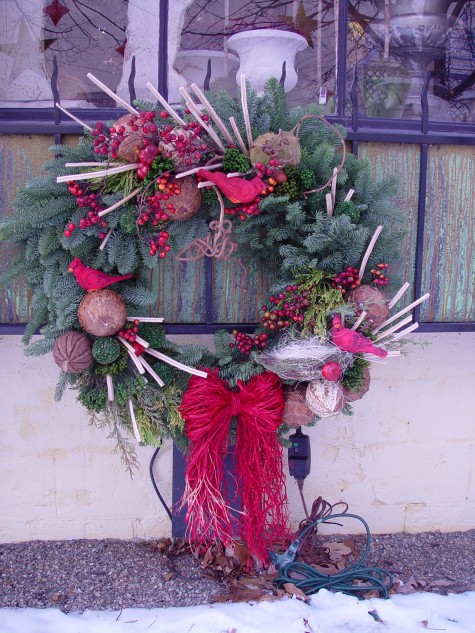 Any faux berry stem needs to be tested for water resistance before it is used. I learned this the hard way; five window boxes full of white styrofoam berries, gel coated in a clear red acetate, dissolved all over the greens and pavement in front of the store of one of my commercial clients. What a mess. A short piece of dried kiwi vine chosen for its curl as a loose element to the mix.
Any faux berry stem needs to be tested for water resistance before it is used. I learned this the hard way; five window boxes full of white styrofoam berries, gel coated in a clear red acetate, dissolved all over the greens and pavement in front of the store of one of my commercial clients. What a mess. A short piece of dried kiwi vine chosen for its curl as a loose element to the mix. 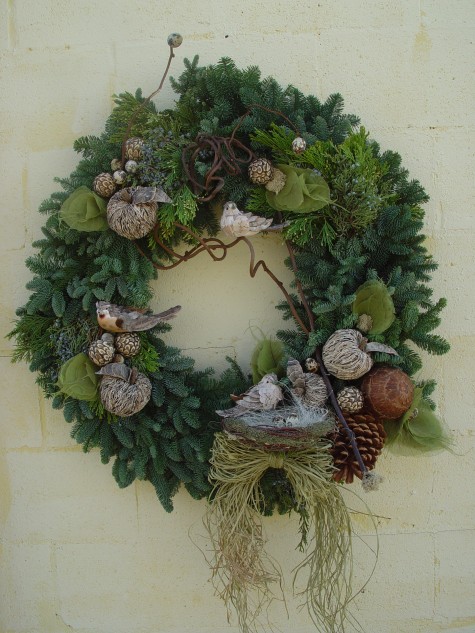 Ornaments made from natural materials are readily available. As with any ornament or stem, I deconstruct some things so the proportions are good with the size of the wreath. Sometimes I only need a wedge cut from a ball, or a portion of a stem. A wreath is a little world that needs to be built accordingly.
Ornaments made from natural materials are readily available. As with any ornament or stem, I deconstruct some things so the proportions are good with the size of the wreath. Sometimes I only need a wedge cut from a ball, or a portion of a stem. A wreath is a little world that needs to be built accordingly.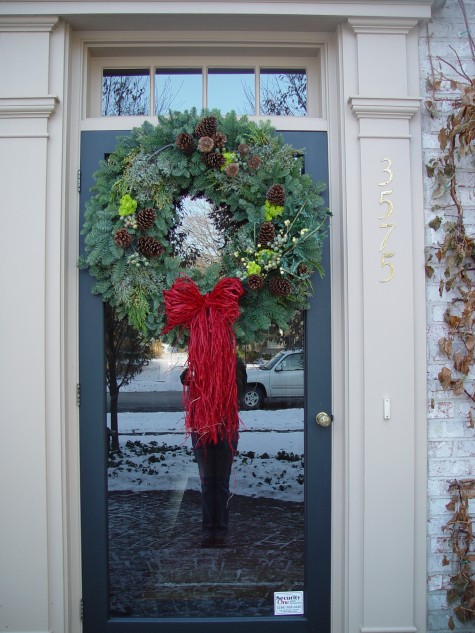 When the front door is a long way from the street, a shot of bright red makes a cheery statement from a distance. Raffia bows have great texture and resilience to the weather. The worst enemy of any wreath is not snow-it is rain. A wreath subjected to a lot of rain can have a good bit of its original shape restored. Take the wreath to a dry place, and dry up side down, and face down; gravity will do wonders.
When the front door is a long way from the street, a shot of bright red makes a cheery statement from a distance. Raffia bows have great texture and resilience to the weather. The worst enemy of any wreath is not snow-it is rain. A wreath subjected to a lot of rain can have a good bit of its original shape restored. Take the wreath to a dry place, and dry up side down, and face down; gravity will do wonders.